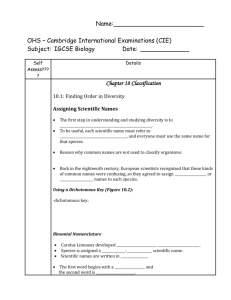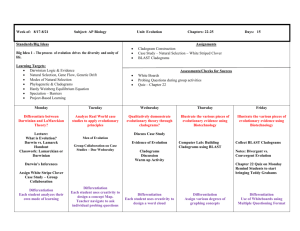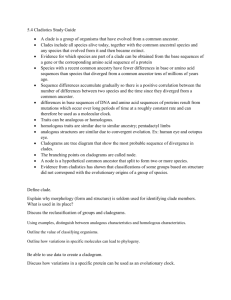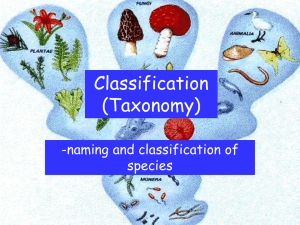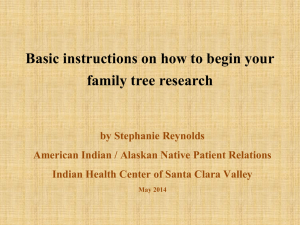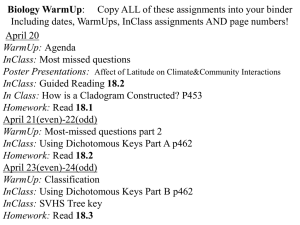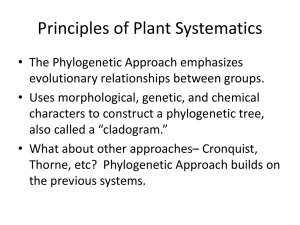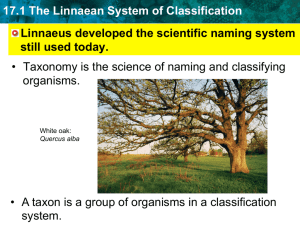Chapter 18 Classification
advertisement
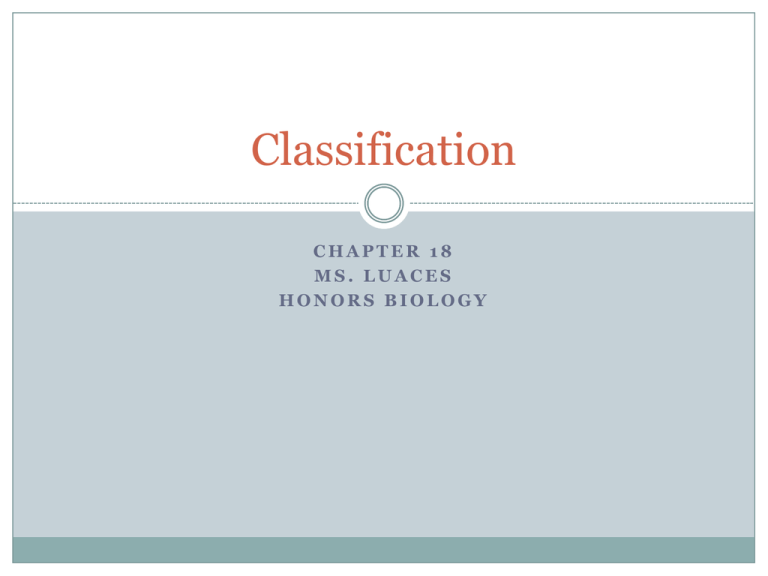
Classification CHAPTER 18 MS. LUACES HONORS BIOLOGY Finding Order In Diversity – 18.1 How do we order species? Has this order changed over time? Will this order continue to change? Assigning Scientific Names First step: describe and give a universally accepted name to each species One of the easiest ways to classify is using a dichotomous key – following a set of steps / questions to arrive at a conclusion Let’s Practice Copy the table below and choose 4 ways to categorize the fruits with members at your table Fruit Apple Pear Orange Kiwi ?? ?? ?? Assigning Scientific Names Linnaeus invented a system of binomial nomenclature – scientific name consisting of Genus species Assigning Scientific Names The goal of systematics is to organize living things into groups that have biological meaning – higher than Genus species The Linnaean Classification System Linnaeus went from developing a system with 4 groups to one with seven hierarchical taxa: Kingdom Phylum Class Order Family Genus Species The Linnaean Classification System As you down the ladder of classification, you get more specific. We go from classifying according to general similarities, to specifics and interbreeding capabilities Kingdom looks at generalities (are you multicellular?) while species looks at specifics (what’s special about you?) The Linnaean Classification System However, how do we decide which similarities and differences are most important? Linnaeus used only similarities and differences with other living organisms. Today, we also look at where in the evolutionary tree does the organism belong and its DNA. Modern Evolutionary Classification – 18.2 Linnaean classification had some faults under Darwin’s theory of evolution… the “tree of life” did not fit under it How do we re-organize our classification to fit molecular evidence? Evolutionary Classification The goal of phylogenetic systematics (evolutionary classification) is to group species into larger categories that reflect the lines of evolutionary descent, rather than similarities or differences Evolutionary Classification Common ancestors – as we go into higher taxa, we get closer to our common ancestor Clades – include a common ancestor and all of its descendants Known as monophyletic – ‘mono’ meaning one ancestor Cladograms A cladogram links groups of organisms by showing how evolutionary lines, or lineages, branched off from common ancestors Cladograms When one species splits off into two (think the finches), we call that a node in a cladogram. That point represents the last point at which two lineages shared a common ancestor Cladograms The bottom, or “root” of the cladogram represents the common ancestor Each branching pattern gives the degree of relatedness between the organisms Cladograms Cladograms depend on derived characteristics (a trait that arose in a recent common ancestor in a particular lineage) while Linnaean only grouped on similarities Sometimes traits are lost in the process of evolution, but it still links them together! Interpreting Cladograms The lowest node represents the last common ancestor Each derived character listed along the main trunk of the cladogram defines a clade Ex: retractable claws are only shared by Felidae (cats) Interpreting Cladograms So where do Linnaeus and cladograms meet? Remember cladograms include the common ancestor and ALL its descendants For example, birds do not fit into the traditional Linnaean taxonomy, but they are reptiles! (come from the same common ancestor). DNA in Classification When organisms don’t have similar physical characteristics, we turn to DNA to help us classify them. In general, the more derived genetic characters two species share, the more recently they shared a common ancestor and the more closely they are related in evolutionary terms. DNA in Classification Example: the Red Panda is more closely related to raccoons than it is to Giant Pandas and Bears Completely different genus! All this information from DNA. 18.2 – Let’s Practice Study Workbook A Pgs. 205-206 Work with a buddy (one sheet of paper). Write the question AND the answer No key concepts Due at the end of class! 18.3 Building The Tree Of Life Kingdoms in the 1700’s consisted only of Plantae and Animalia. Today, we have 6 Kingdoms: Eubacteria Archaebacteria Protista Fungi Plantae Animalia 18.3 Changing Ideas About Kingdoms As research became more readily available, the kingdoms went expanding according to different characteristics each of the cells exhibited Pg. 524, Figure 18-14 should be copied in your notes! 18.3 Changing Ideas About Kingdoms Kingdoms were not the only ones to change – Domains changed too! Went from Eukaryotes and Prokaryotes to Eubacteria, Archaebacteria and Eukarya 18.3 The Tree Of Life The tree of life shows current hypotheses regarding evolutionary relationships among the taxa within the three domains of life It is not fact or permanent, it’s constantly changing as we discover new things! 18.3 The Tree Of Life Domain Bacteria: Unicellular Prokaryotic Thick cell walls with peptidoglycan Can use photosynthesis or oxygen (or not) Kingdom Eubacteria 18.3 The Tree Of Life Domain Archaea: Unicellular Prokaryotic Extremophiles Anaerobic (no oxygen) Cell walls with no peptidoglycan Kingdom Archaebacteria 18.3 The Tree Of Life Domain Eukarya: Have nucleus Kingdom Protista Kingdom Fungi Heterotrophs who feed on decaying matter and have chitin in their cell walls Kingdom Plantae Many different characteristics (uni / multicellular, anaerobic/aerobic) and paraphyletic (not a true clade) Autotrophs that have cellulose in their cell walls and do photosynthesis Kingdom Animalia Multicellular and heterotrophic with no cell walls Let’s Practice! Study Workbook A Pgs. 207-209 One sheet of paper for both of you, QUESTION & ANSWER No key concepts Due at the end of class!
